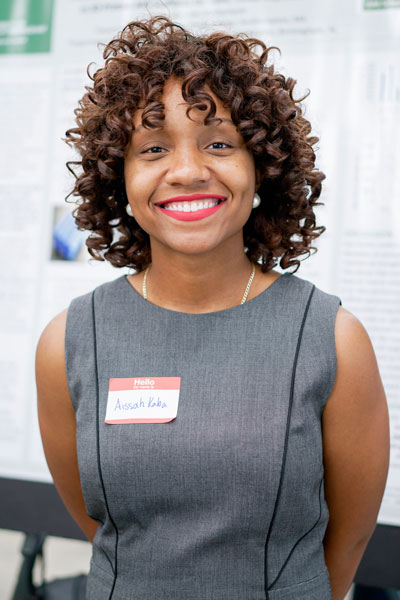 Aissah KabaFor 21 years, the National Science Foundation has supported summer undergraduate research at the University of Alabama at Birmingham.
Aissah KabaFor 21 years, the National Science Foundation has supported summer undergraduate research at the University of Alabama at Birmingham.
The 10 students at UAB this summer came from schools as far-flung as San Diego State and Brigham Young universities, and as different in size as Oakwood University in Huntsville and the 52,000-student University of Florida.
Aissah Kaba, who grew up in Harlem, was one of those supported by the NSF-Research Experiences for Undergraduates award to UAB, administered by the UAB physics department. Kaba is a rising junior majoring in engineering at Smith College, Northampton, Massachusetts.
“Northampton was a huge shock,” Kaba said. “The town only spans a couple of blocks, something I am not used to in the huge city of New York. It was also eerily quiet and dark sometimes, which is unheard-of in the city that never sleeps.”
Kaba had not been to the Deep South and was a bit nervous about Alabama, but her summer turned out to be “a great experience.” Kaba lived in a four-bedroom suite in Blount Hall with other student researchers, and she was surprised by the large size of UAB compared with her 2,500-student Smith campus.
She was also impressed by the Birmingham Civil Rights Institute. “It was amazing to see,” Kaba said. “What I liked the most about it was that it was vivid, they did not shy away from revealing the truth of what Birmingham used to be. They truly created an experience in which you went through Birmingham’s frightful past, as well as its promising future.”
Kaba worked in the lab of Alan Eberhardt, Ph.D., professor of biomedical engineering in the UAB School of Engineering, fashioning three-dimensional thermoplastic polymer scaffolds for bone repair.
The ABS scaffolds, cubes a little under 1 inch wide with open spaces where bone cells can grow, need to be strong enough to bridge a missing piece of bone called a segmental defect. In her research, Kaba explored the effects of porosity and orientation on mechanical strength of the printed scaffolds.
“I wanted to see if we could create scaffolds that had a stress level of 100 to 200 megapascals, which is that of cortical bone,” Kaba said. In legs, the cortical bone is the thin outer ring of hard bone that supports most of the force of standing, running or jumping. The porous inner bone is much softer.
Taking a subway to school
Kaba’s interest in mechanical engineering came in high school from watching the “Deadliest Warrior” TV show, which compares historical and modern warriors and their weapons. “There was a biomechanical engineer, Geoff Desmoulin, who explained how the different materials protected warriors,” Kaba said.
| “I felt confident in myself as well as in my preparation… I was able to talk to different people about my research and hear feedback about how I could improve.” |
To get more science experience, Kaba traveled one hour each way by subway to attend The Brooklyn School for Math and Research. “My mom supported my choice,” she said.
Kaba then won a merit-based scholarship from the Posse Foundation and Smith College, for public high school students with extraordinary academic and leadership potential who may be overlooked by the traditional college selection process. Kaba became one of the first group of Posse STEM — science, technology, engineering and math — students at Smith.
At UAB, Kaba says, the summer-ending public presentation and poster session was especially valuable for her professional growth. “As a person who gets nervous when speaking publicly, having to give a presentation and participate in a poster session seemed daunting in the beginning,” she said. “I was worried that I would overthink things, and that would lead to a slip.
“However, the presentation actually went really well. Due to the presentation, I was able to practice how to talk about my research in a clear manner, as well as prepare for the types of questions that may be asked.”
In the poster session at the Summer Expo — where nearly 170 student researchers stood in front of their posters outlining their work, “I felt confident in myself as well as in my preparation, and that allowed me to have a fun time at the Expo,” Kaba said. “I was able to talk to different people about my research and hear feedback about how I could improve.”
That fit in with the Summer Expo keynote address by Stephen Yoder, J.D., assistant professor and honors program director in the UAB Collat School of Business. He talked about his own journey during and after an undergraduate research experience and said his lifelong intellectual, professional and personal growth were all influenced by that undergraduate experience.
“That’s why we have the undergraduate research expo program,” Yoder said. “I grew intellectually. I started to learn about being a professional, and I grew as a human being. I was a better team player and became more sympathetic.”